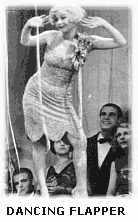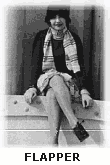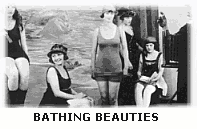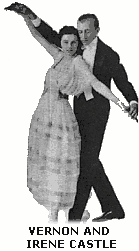
|
Now Playing


"... the flapper came in to the tune of 'I'll Say She
Does'--and frequently she did ..."
--LLoyd Morris, Incredible New York
 The Methodist Episcopal Book of Discipline had always contained a ban on dancing and
games of chance and on such kindred diversions of "questionable moral tendency" as theaters, race
tracks and circuses. The penalty for straying from these hard concepts was expulsion from
the church. In March 1920,
the New Jersey Methodist Episcopal Conference voted to raise the
moral curtain.
The Methodist Episcopal Book of Discipline had always contained a ban on dancing and
games of chance and on such kindred diversions of "questionable moral tendency" as theaters, race
tracks and circuses. The penalty for straying from these hard concepts was expulsion from
the church. In March 1920,
the New Jersey Methodist Episcopal Conference voted to raise the
moral curtain.  America had been dancing something besides the minuet since 1912, when the fox
trot and the tango began to sizzle the boards. Noted Frederick Lewis Allen in The Big
Change: "At any rate, by 1920, the rebellion against puritanism and stuffiness was widely
visible, and it gained in impetus as the decade progressed." America had been dancing something besides the minuet since 1912, when the fox
trot and the tango began to sizzle the boards. Noted Frederick Lewis Allen in The Big
Change: "At any rate, by 1920, the rebellion against puritanism and stuffiness was widely
visible, and it gained in impetus as the decade progressed."
Lloyd Morris, in Incredible New York, had this to say about the girls: "If your concern
was paternal, the flapper was a problem. Otherwise, she was a pleasure. Jauntily
feather-footed in her unfastened galoshes, her flesh-colored stockings rolled below the knee and
her skirt barely touching it, slender and boyish, the flapper came in to the tune of 'I'll
 Say She Does'--and frequently she did. Her seniors soon caught on. The woman
you saw shopping on Fifth Avenue didn't suggest matrimony and motherhood. Their shingled
hair was peroxided or hennaed, their eyebrows were plucked and penciled, their eyelids were beaded,
Say She Does'--and frequently she did. Her seniors soon caught on. The woman
you saw shopping on Fifth Avenue didn't suggest matrimony and motherhood. Their shingled
hair was peroxided or hennaed, their eyebrows were plucked and penciled, their eyelids were beaded,
 their cheeks and lips were piquantly rouged. Except for their
silver-fox or mink jackets, the
sum of what they wore could almost have been packed into their handbags. Smart leather-goods
shops were advertising the novelty of an 'overnight case.' It seemed a primary requisite for
women who, in the current phrase, were bent on 'leading their own lives.'"
their cheeks and lips were piquantly rouged. Except for their
silver-fox or mink jackets, the
sum of what they wore could almost have been packed into their handbags. Smart leather-goods
shops were advertising the novelty of an 'overnight case.' It seemed a primary requisite for
women who, in the current phrase, were bent on 'leading their own lives.'"
John Held, Jr., drew the classic portraits of the
flapper and Joe College that appeared in College Humor and in the old Life magazine . . .
Irene and Vernon Castle, performing before World War I, did much to launch the ballroom dancing craze
which made huge strides in the twenties. Mrs. Castle is credited with starting the bobbed-hair
style. The story is that some of her hair was burned accidentally and she had to cut it short.
On her it looked good, and she pioneered an enduring fashion.
[ more 1920 ]
[ previous page ]
[ back to top ]
[ next page ]
copyright © Estate of Paul Sann
NOTICE OF COPYRIGHT
|



 The Methodist Episcopal Book of Discipline had always contained a ban on dancing and
games of chance and on such kindred diversions of "questionable moral tendency" as theaters, race
tracks and circuses. The penalty for straying from these hard concepts was expulsion from
the church. In March 1920,
the New Jersey Methodist Episcopal Conference voted to raise the
moral curtain.
The Methodist Episcopal Book of Discipline had always contained a ban on dancing and
games of chance and on such kindred diversions of "questionable moral tendency" as theaters, race
tracks and circuses. The penalty for straying from these hard concepts was expulsion from
the church. In March 1920,
the New Jersey Methodist Episcopal Conference voted to raise the
moral curtain.  America had been dancing something besides the minuet since 1912, when the fox
trot and the tango began to sizzle the boards. Noted Frederick Lewis Allen in The Big
Change: "At any rate, by 1920, the rebellion against puritanism and stuffiness was widely
visible, and it gained in impetus as the decade progressed."
America had been dancing something besides the minuet since 1912, when the fox
trot and the tango began to sizzle the boards. Noted Frederick Lewis Allen in The Big
Change: "At any rate, by 1920, the rebellion against puritanism and stuffiness was widely
visible, and it gained in impetus as the decade progressed." Say She Does'--and frequently she did. Her seniors soon caught on. The woman
you saw shopping on Fifth Avenue didn't suggest matrimony and motherhood. Their shingled
hair was peroxided or hennaed, their eyebrows were plucked and penciled, their eyelids were beaded,
Say She Does'--and frequently she did. Her seniors soon caught on. The woman
you saw shopping on Fifth Avenue didn't suggest matrimony and motherhood. Their shingled
hair was peroxided or hennaed, their eyebrows were plucked and penciled, their eyelids were beaded,
 their cheeks and lips were piquantly rouged. Except for their
silver-fox or mink jackets, the
sum of what they wore could almost have been packed into their handbags. Smart leather-goods
shops were advertising the novelty of an 'overnight case.' It seemed a primary requisite for
women who, in the current phrase, were bent on 'leading their own lives.'"
their cheeks and lips were piquantly rouged. Except for their
silver-fox or mink jackets, the
sum of what they wore could almost have been packed into their handbags. Smart leather-goods
shops were advertising the novelty of an 'overnight case.' It seemed a primary requisite for
women who, in the current phrase, were bent on 'leading their own lives.'"